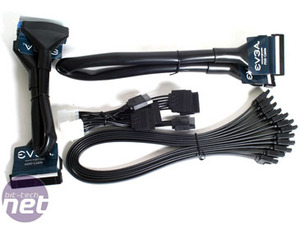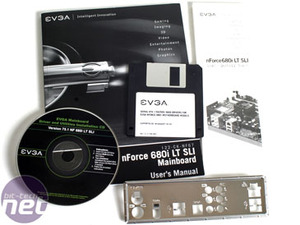Nice Package...
The included package is really very good, with everything adorned in this season’s black. There is an entire complement of long 50cm black SATA cables (could these be ‘too’ long? – Ed), along with black IDE and floppy cables and PCI brackets for four USB ports, one RS232 serial port and a six-pin Firewire port. Even the molex to SATA power adapters wiring get the all zero treatment.Including all four USB ports on one PCI bracket means less PCI slots are used and you still are able to use all the ports available. The Firewire and Serial ports could have been included on a single PCI bracket since there is space, although it’s not exactly a common combination. Finally, there is also a quick install guide, comprehensive manual and driver floppy and CD.
Overall it’s a pretty decent bundle, offering everything the motherboard supports and not including unnecessary extras that increase the price. Whilst some people may love a free T-shirt or case sticker, everybody pays for it, and EVGA quite rightly doesn’t include them here.
Motherboard Layout
The motherboard PCB has been changed to boring and generic green rather than the fractionally more expensive but sexier black. This way people won’t confuse the two varieties of nForce 680i. There is no real theme across the board, and to be honest there could have been more effort applied since this is still a performance-enthusiast orientated motherboard. Simply replacing the blue memory slots for green would have at least indicated that there was some effort made on this front.Overall, its layout is still a unique design compared to the industry as a whole, but also one that is a bit hit and miss depending on your case and hardware needs.
For starters, there is a lot bunched around the central right hand edge of the board. Whilst we normally praise the location of sockets near the edges of the board, actually putting so many in such close proximity makes the task of plugging everything in (or worse, unplugging something) quite difficult. Having IDE, four SATA, additional molex power, front panel pin outs and memory sockets clustered in the space of a few square inches of PCB real estate makes getting in those pinkies a real issue. Having said all that, if you systematically plan your case and plug everything in from the inside outwards you can minimise the stress.
There are still two SATA ports at 90 degrees to the board at the edge lower down, to minimise cable mess, however the front panel pin out is unusually placed in the middle of the board. Whilst this will help those with cases that have buttons in the roof, like the CoolerMaster Stacker, these cases are designed for use with every motherboard, and every other motherboard on the market has their front panel pin outs in the bottom right hand corner.
The memory slots are placed high enough so as you don't have to remove the graphics card when removing memory. We have found that, with the move to Vista recently, more people are installing 4GB of memory in their systems and falling into difficulty using four sticks of dual sided DIMMs. We installed 4GB of OCZ FlexXLC PC9200 into the system and it booted into Windows perfectly. We even mixed two types of Corsair Dominator and OCZ FlexXLC and it still worked fine, even at enhanced timings, so no such problems here.

MSI MPG Velox 100R Chassis Review
October 14 2021 | 15:04













Want to comment? Please log in.